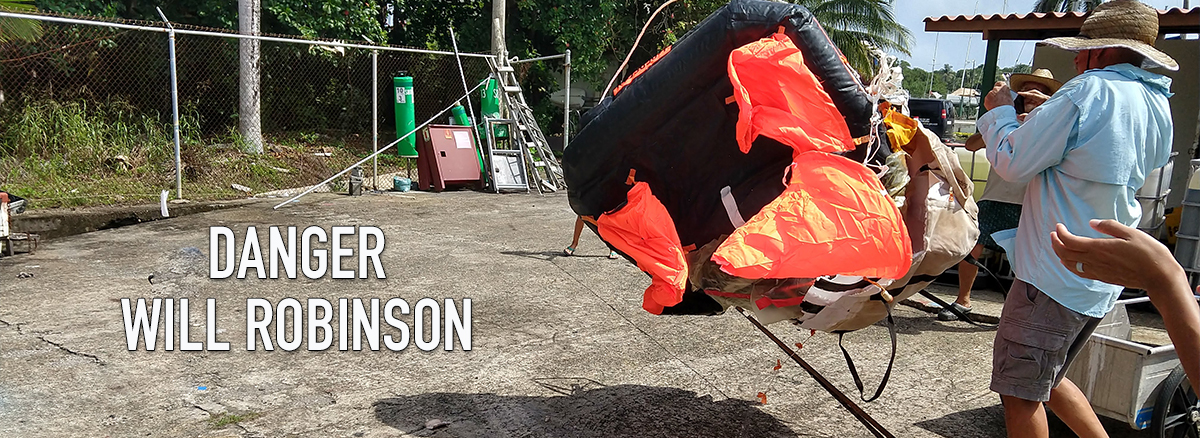

DANGER WILL ROBINSON - YOUR LIFE RAFT CAN KILL YOU ON DRY LAND
When you inflate a life raft on dry land, it flies through the air with the greatest of ease.
It’s actually dangerous to be standing closer than 12 feet from the raft when inflating it on dry land using the CO2 metal tank found on the raft.
As you can see from the picture, the raft inflates so rapidly that it jumps at least three feet into the air.
No problem - right?
Wrong.
The CO2 cylinder attached to the raft jumps up in the air as well, and if it the cylinder hits you in the head, it could easily fracture your skull. If the cylinder thumps you on the chest, it could break ribs, and if it hits you in the arm or leg, it could fracture a long bone.
When the rip chord was pulled to inflate this raft, it instantly jumped at least six feet in my direction, and I had to quickly step backward to avoid being clobbered by the leaping orange raft.
The tether/inflation line on a life raft is usually at least twenty feet long so you will be well away from the raft when it inflates.
It’s a big mistake to inflate a life raft on deck. Not only could it hurt someone in the inflation process, the flying life raft could be punctured by sharp objects on deck destroying it.
When you deposit a life raft in the ocean, you should put it on the downwind side of the boat. That way the raft will not be pushed against the side of the boat and possibly be punctured by sharp objects.
You attach the tether to the downwind side of the boat, and then you throw the life raft into the water. After the raft drifts away a safe distance, you pull on the tether to inflate the raft. After the raft is fully inflated, you use the tether to maneuver the raft to a safe location where it cannot be damaged and where people can climb onboard.
Pulling the rip chord on the raft is a one time event. The rapid inflation with the extremely cold CO2 is hard on the seams and overall structure of the raft. For all practical purposes, an inflation event is a death sentence for the raft.
When you get your life raft inspected and recertified, it is inflated slowly with room temperature air that will not stress the seams of the raft. They leave the raft inflated for several days just to make sure it holds air - to be sure the overpressure valves are not leaking and the seams are all secure.
They also weigh the CO2 cylinder to make sure that there is sufficient CO2 in the cylinder to inflate the raft in an emergency.
Then they pack it back into your canister or valise and replace it on your boat.
It’s important who repacks your life raft. I have heard of one instance where unethical individuals put a bag of sand in the life raft canister, and it was not until the next life raft inspection that the sailors discovered they did not have a raft. If they had pulled on the rip chord coming out of the canister, nothing would have happened because all they had was a bag of sand - a tiny beach in a stormy ocean - not a pleasant discovery.
Awesome music video that captures the essence of what it's like to sail offshore in a catamaran around the world when conditions are less than perfect. David Abbott from Too Many Drummers sings the vocals, and he also edited the footage from our Red Sea adventures. This is the theme song from the Red Sea Chronicles.
Sailing up the Red Sea is not for the faint of heart. From the Bab al Mandeb to the Suez Canal, adventures and adversity are in abundance. If you take things too seriously, you just might get the Red Sea Blues.
If you like drum beats, and you like adventure, then have a listen to the Red Sea Chronicles Trailer.
Flying fish assault Exit Only in the middle of the night as we sail through the Arabian Gulf from the Maldives to Oman. And so begins our Red Sea adventures.
Sailing through Pirate Alley between Yemen and Somalia involves calculated risk. It may not be Russian Roulette, but it is a bit of a worry. Follow Team Maxing Out as they navigate through Pirate Alley.
Stopping in Yemen was just what the doctor ordered. We refueled, repaired our alternator, and we made friends with our gracious Yemeni hosts. We also went to Baskins Robbins as a reward for surviving Pirate Alley.
After you survive Pirate Alley, you must sail through the Gate of Sorrows (Bab Al Mandab) at the southern entrance to the Red Sea. The Gate of Sorrows lived up to its name with fifty knots of wind and a sandstorm that pummeled Exit Only for two days. Life is good.
Although I like the feel of a paper book in my hand, I love trees even more. When people purchase an eBook, they actually save trees and save money as well. Ebooks are less expensive and have no negative impact on the environment. All of Dr. Dave's books are available at Save A Tree Bookstore. Visit the bookstore today and start putting good things into your mind. It's easy to fill your mind with positive things using eBooks. No matter where you are or what you are doing, you can pull out your smart phone or tablet and start reading. You can even use electronic highlighters and make annotations in your eBooks just like paper books.